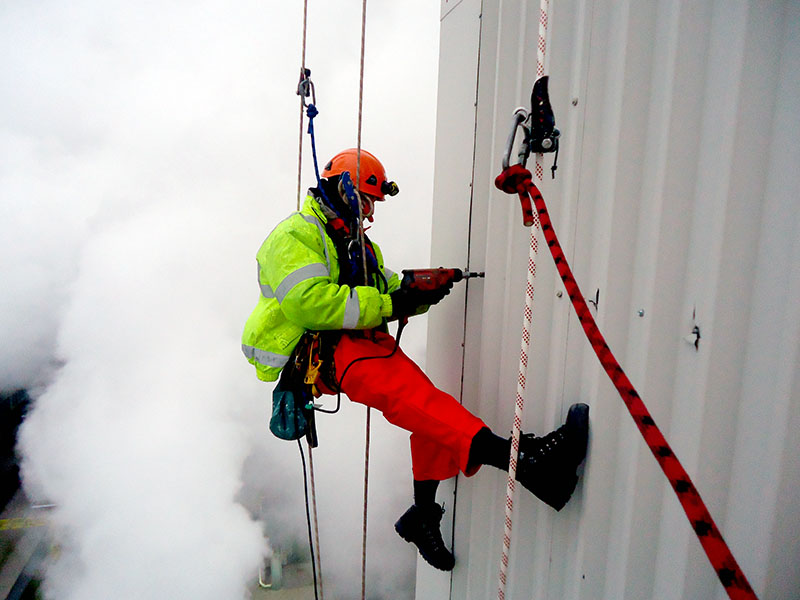In working at heights, many elements are essential when carrying out certain tasks and guaranteeing the safety of the operators. As experts in vertical work as access experts we tell you what is the importance of anchors in vertical work and how to choose the most suitable for you.
Basic parts of a lifeline
The lifelines are an anti-fall system that is made up of different anchoring devices, a harness or belt and a connection subsystem.
Anchor point: It is the element to which it can be connected to a personal protective equipment after its assembly. For example, the hole or part to which you connect a carabiner or a lifeline cable.
Anchor line: It is the one that allows the operator to move along the system. Its extension and type depend on the work to be carried out.
Energy absorber: It is an element responsible for dissipating the kinetic energy that develops in a fall.
Lanyards: It is also known as a lanyard and can be fixed or adjustable.
Harness: It is a device that adjusts to the operator's body, and its main function is to stop falls.Importance of anchors in vertical work
Anchors are one of the most important items in the personal fall protection equipment (PPE) of rope access operators. This system is the one that allows to connect or fix the equipment to certain structures.
They need to have adequate strength to stop a fall. They must comply with the provisions of Standardization (UNE), specifically the EN 795 and EN 353 standards.
In EN 795, they establish that an anchoring device must have a minimum resistance of 12kN in the direction in which the force is applied in case they are metallic. If they are not, the resistance must be 18kN.
While EN 353 specifies another series of guidelines, requirements and marking with which the equipment that is part of the protection systems against falls from a height for individual use must comply.
In addition, for each job at height, there is a corresponding type of anchor that adapts to the needs of the operator and the demands of the task to be carried out. For this reason, selecting a suitable system is important to guarantee worker safety.
The anchors must be selected according to the work to be done. Otherwise, the operator’s safety could be affected, hence the importance of anchors in vertical work.
There are several ways to classify anchors. Some of the types most used in work at height are:
Fixed and structural anchors
They are permanently attached to a structure. They are used when access to said element is quite frequent. For example, on glass facades that must be cleaned regularly.
They are usually fixed by welding, drilling a hole in the surface and inserting the anchor or using materials such as cement or chemical resins.
Temporary anchoring system
They are those anchors that are not permanently fixed in the structures. They are only placed when a specific height job is to be carried out and once completed, and it is removed. They are widely used when conducting inspections of facades, roofs, and roofs.
This type of anchoring system is considered as PPE and requires the European Conformity or CE marking.
Vertical anchoring systems
As the name implies. They are a set of elements that allow the operator to move vertically or from top to bottom throughout the entire system. This can be fixed or portable
Vertical anchoring systems must be easy to connect and use. They can also have flexible or rigid cords depending on the job.
Horizontal anchoring systems
This type of system is designed so that the operator can move on horizontal surfaces. In these cases, the anchor lines are used to restrict access to areas with risk of falls and, in turn, as an element to stop falls should they occur.
System lifelines can be flexible or rigid. And it is common for them to be used in industrial roof and roof maintenance work.
Anchors outside the norms
In some cases it is allowed to use anchors that are out of the norm. But this does not mean that they should not meet a number of parameters.
To use an anchoring system, a document must be created stating that said element meets the requirements of the different laws. This is done to facilitate any post-job review process. Also, in case of inquiries after an accident.
Among the data that must be specified in the documentation, the following must be obligatorily included:
The exact location of the system installation.
Full name and other relevant data of the person responsible for the installation of the system.
Installation company details.
Make, model, type, strength, and other pertinent information about the anchor device and the fixing system.
An installation drawing is specifying the anchor points on the surface.
A technical report signed by the company that installed the system ensures that the process was carried out following the manufacturer's instructions and applicable regulations.Now that you know the importance of anchors in vertical work, you know that it is an indispensable element that allows operators to be safe at heights while moving. If you are looking for a team of experts in facade maintenance and waterproofing, contact us and ask for a quote.
One of these tasks is linked to the cleaning sector, in its many versions, having, of course, as a conditioning factor, carrying out this type of work at height. In this sense, the majority of vertical work companies, at some point, have carried out cleaning and adaptation tasks of facades, windows, monuments, ventilation ducts, warehouses, roofs, roofs, posts, structures, etc.
This growth has been the consequence of continuous evolution, both from the point of view of the companies, as well as the use of equipment, devices, specific devices for these techniques, application, and improvement of the products to be used, development and application of the best access techniques at height, adaptation to the environment, specialized training, technical standards, and work procedures, and thus a large number of factors that have made these techniques a method, as indicated above, effective and safe.
Concerning these last two aspects, it is also important to add another one, which response to the speed of action, not only in ’emergencies but also, if not to the fact of being able to give a quick, economical and quick response and solution justified to most of the cleaning actions that must be carried out at height, compared to the traditional means of working at height.





